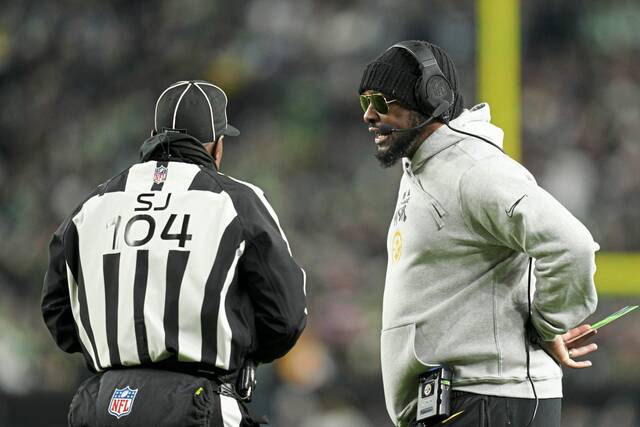https://triblive.com/sports/nfl-officiating-expert-gene-steratore-explains-controversial-calls-in-steelers-eagles-game/
NFL officiating expert Gene Steratore explains controversial calls in Steelers-Eagles game

During his weekly appearance on WDVE, CBS NFL rules analyst Gene Steratore discussed a number of officiating decisions in the Steelers’ 27-13 loss at Philadelphia on Sunday.
The one that seems to have inflamed Steelers fans (and players) the most is the scrum that broke out in the first half when Steelers tight end Darnell Washington blocked Eagles defensive back Darius Slay through the end of the play … and through the back of the end zone.
Washington got an unnecessary roughness penalty. Slay took exception and started throwing punches, as did other Eagles. Many of those haymakers were caught on camera by fans and were clearly within view of some officials who came in to break up the fray.
However, the only additional penalty to be assessed from the fracas was pinned on the Steelers’ Calvin Austin for essentially being the third man into the rumble.
View this post on Instagram A post shared by NFL on CBS (@nfloncbs)As a former referee, Steratore, a Uniontown native and Washington County resident, empathizes with the crew attempting to calm down the chaos, but he says those punches were just flat-out overlooked.
And not just by the on-field officials.
“When there is a flag on the ground for hits at the end of a play, things of the nature that we saw, New York does get involved and has access to all cameras,” Steratore said of the replay assist system. “And then they weigh in and make a decision as to see if any of these actions would elevate to a possible ejection. And as we all saw, a couple of pretty good right-handed haymakers were thrown, but nothing done on it.”
The result of the fight meant that a first-and-10 gain of 7 yards down to Philadelphia’s 4-yard line turned into a second-and-18 from the Philly 19-yard line. So the Steelers ended up with just a field goal instead of a potential touchdown, or at least maybe a first-and-goal.
Another call that drew a great deal of attention was Steelers defensive lineman Montravius Adams’ personal foul in the third quarter for contacting the long snapper on a successful field goal attempt by the Eagles.
Philadelphia took the points off the board, continued the drive and netted 7 more yards. But the offense didn’t pick up an additional first down and just kicked the field goal again. So the play ended up being inconsequential aside from the lost time on the clock.
However, Steelers fans were still upset because it appeared that Adams had been shoved onto the long snapper by the left guard as opposed to hitting him by choice.
I’m sorry. This is a 15-yard penalty??? It’s football. Not checkers. pic.twitter.com/CsGNXJnXVB— Andrew Fillipponi (@ThePoniExpress) December 15, 2024
Whether that complaint was valid or not (and I maintain that it was), Steratore insists that if a defender like Adams tries to block a kick by shooting the gap next to the long snapper, he is setting himself up for a flag because of how tightly the on-field officials are being told to protect the long snappers since they are in a vulnerable position.
“The message is clear. We’ve given them a little bit of leeway on some of these things. But now we are seeing this go to a place where we don’t want it, we are going to tighten this up now,” Steratore said. “So now, when you see this behavior at this level, this is a foul.”
Basically, it sounds like — whether Adams was shoved into the long snapper or not — he put himself in a position to be shoved there and the onus is on him.
How or why? I’m still not sure. Then again, that’s the NFL rulebook when it comes to adjudication against defensive players and an illogical expectation to protect player safety in an inherently violent contact sport.
Finally, for a sportscast later in the morning show, I also asked Steratore to explain why Jalen Carter’s personal foul for smacking Steelers tight end Connor Heyward in the head during a punt was assessed as a penalty after the Eagles got possession, even though the incident occurred before Pittsburgh punter Corliss Waitman kicked the ball.
This is how close Jalen Carter was to costing the Eagles possession.In fact, since the ball has not been punted yet, it could've given them an automatic 1st down. The flag came out a second later when ball was punted, but a split second from a potentially game-changing mistake. pic.twitter.com/jFOvvjuuZ4
— Eagles Eric (@EaglesXsandOs) December 16, 2024
Carter out here throwing hands. #eagles #steelers pic.twitter.com/5UzoLVRqMo
— Rate the Refs App (@Rate_the_Refs) December 15, 2024
Had the officials deemed that to be a pre-punt foul, the Steelers would’ve been given a first down and extended their drive. Instead, the Eagles merely suffered a half the distance to the goal-line penalty. Since they originally took over possession at their own 6-yard line, the infraction only cost Jalen Hurts and the offense 3 yards.
Steratore explained that the nanosecond difference between the act of the head slap and the punt, combined with the pre-kick/post-kick nature of the fouls, probably led to the Eagles catching a break.
“It’s when the defensive fouls are egregious enough that they could compromise the play itself,” Steratore said. “It’s pull-and-shoot, leaping, leverage, things like that on the defense — a hold that may take place on the outside at the snap and then the punt goes off.”
In other words, since the Eagles didn’t gain an advantage toward blocking the kick or setting up for a return, the officials aren’t usually looking to drop a pre-kick penalty on an excessive force foul like Carter’s so close to when the punt was cleanly getting away.
“That’s how they bucket those plays,” Steratore continued. “Even though this foul occurred a second or a half-second before the ball hit the punter’s foot, it’s not of the flavor of that pull-and-shoot, defense gains an advantage, to try to block the kick.”
Understood.
That said, the impact of the decision was significant because instead of Pittsburgh keeping the ball, Philadelphia took over with a little over 10 minutes left and never gave the ball back to the Steelers.
To be clear, none of these calls directly influenced the outcome of the game. The Steelers were outplayed soundly enough that even if the officiating had gone their way most of the day, they probably still would’ve lost.
The point is that the officiating in this game was spotty at best.
Then again, sadly, that’s been the norm in the NFL for years now, hasn’t it?
Listen to Steratore’s comments on WDVE.
More sports• Tim Benz: With the Steelers, the harder you look for silver linings the more rust you’ll find • First Call: George Pickens insists of a ‘vendetta’ against Steelers … again; Diontae Johnson won’t play vs. Steelers • Mark Madden: Steelers’ humbling loss to Eagles revealed certain truths
Copyright ©2026— Trib Total Media, LLC (TribLIVE.com)
